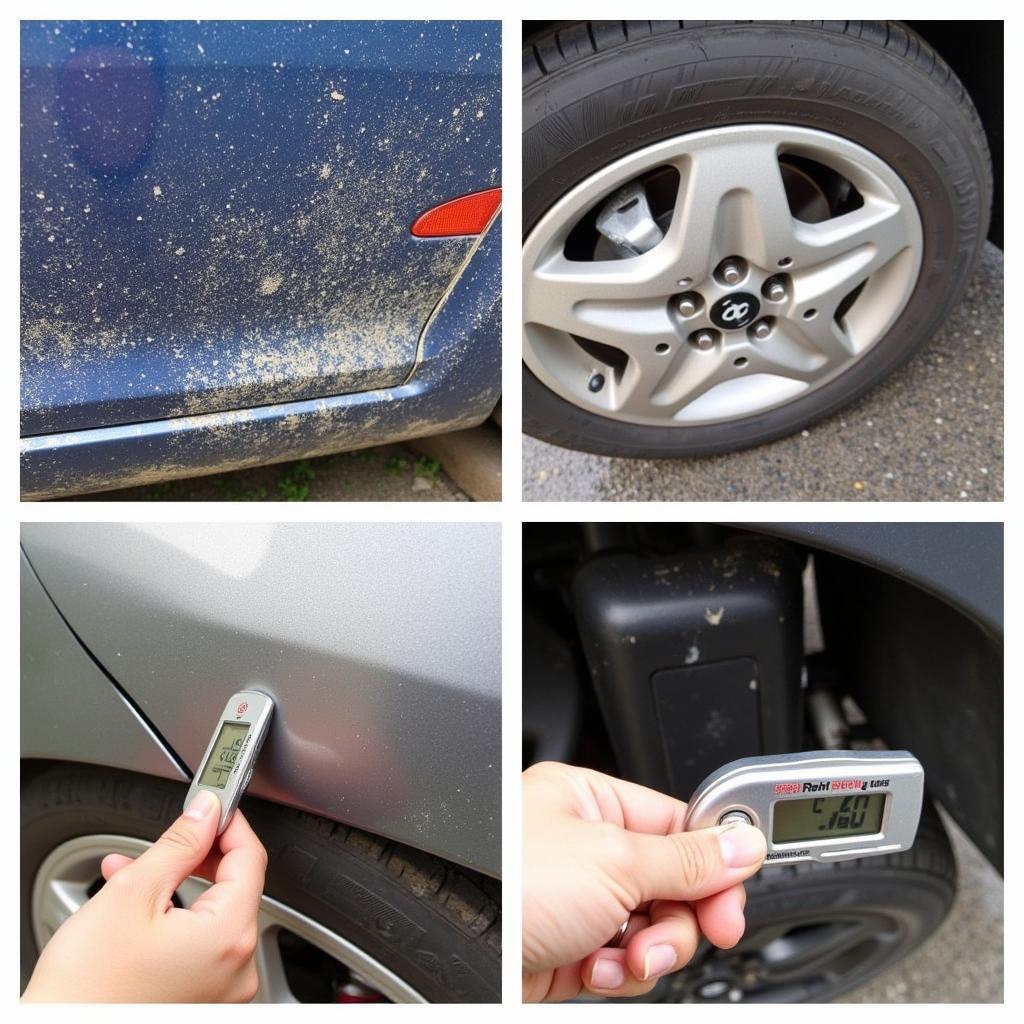Detailing A Nasty Car can be a daunting task, but with the right approach and a bit of elbow grease, you can restore your vehicle to its former glory. This guide will walk you through the process, from assessing the damage to applying the finishing touches, ensuring your car looks its best inside and out.
Assessing the Damage: Know Your Enemy
Before you begin detailing a nasty car, it’s crucial to assess the extent of the damage. This will help you determine the necessary tools, products, and time required for the job. Take a walk around the vehicle, noting any scratches, dents, stains, or other imperfections. Check the interior for dirt, grime, pet hair, and unpleasant odors. The more thorough your assessment, the better prepared you’ll be.
What are the key areas to focus on when inspecting a heavily soiled car? Look for ingrained dirt, stubborn stains, mold or mildew, pet hair, and any signs of damage to the paint or interior.
Exterior Assessment: From Top to Bottom
Start with the exterior, examining the paint for swirl marks, scratches, and oxidation. Check the wheels and tires for brake dust and grime. Inspect the glass for water spots and streaks. Don’t forget to examine the undercarriage for mud and debris.
 Exterior Assessment of a Heavily Soiled Car
Exterior Assessment of a Heavily Soiled Car
Interior Assessment: Deep Dive Inside
Move on to the interior, paying close attention to the seats, carpets, and dashboard. Look for stains, rips, tears, and general wear and tear. Check the headliner for dirt and sagging. Inspect the door panels for scuffs and scratches. Don’t underestimate the power of a good sniff test to identify any lingering odors.
The Detailing Process: A Step-by-Step Guide
Now that you’ve assessed the damage, it’s time to begin the detailing process. This involves a series of steps, each designed to address specific issues and bring your nasty car back to life.
Washing and Decontamination: The First Line of Defense
A thorough wash is the foundation of any detailing job. Use a quality car wash soap and a two-bucket method to avoid scratching the paint. Follow up with a decontamination process using a clay bar or iron remover to remove embedded contaminants.
What’s the two-bucket method? One bucket contains your soapy water, and the other contains clean water for rinsing your wash mitt. This prevents cross-contamination and minimizes scratches.
Paint Correction: Removing Imperfections
If your car’s paint has swirl marks, scratches, or other imperfections, paint correction is the next step. This involves using polishing compounds and machines to level the paint and restore its shine.
Protection: Shielding Your Investment
Once the paint is corrected, it’s essential to protect it with a sealant or wax. This will help prevent future damage and keep your car looking its best.
Interior Detailing: Cleaning and Conditioning
Don’t neglect the interior! Vacuum the carpets and seats thoroughly. Use specialized cleaners to remove stains and grime. Condition leather seats to restore their suppleness and protect them from cracking.
“A clean car is a happy car,” says renowned detailing expert, James P. Carter. “But a truly detailed car is a reflection of the owner’s pride and attention to detail.”
Finishing Touches: The Devil is in the Details
The final step is to add the finishing touches. This might include dressing the tires, cleaning the windows, and applying a protectant to the dashboard and other interior surfaces.
Conclusion: Enjoy Your Revived Ride
Detailing a nasty car can be a labor of love, but the results are well worth the effort. By following these steps, you can transform your vehicle from an eyesore into a head-turner. Remember, regular detailing not only enhances your car’s appearance but also helps preserve its value.
FAQ
- How often should I detail my car? Ideally, every 3-6 months.
- What is the best car wash soap to use? A pH-neutral formula is recommended.
- Can I detail my car myself? Absolutely! With the right tools and knowledge, you can achieve professional results.
- How much does professional detailing cost? Prices vary depending on the services required.
- Is it worth paying for professional detailing? If you lack the time or expertise, professional detailing is a worthwhile investment.
- What’s the difference between detailing and washing a car? Detailing goes beyond a simple wash, addressing every aspect of the car’s appearance.
- What are some common detailing mistakes to avoid? Using abrasive cleaners, neglecting the interior, and not protecting the paint are common mistakes.
“Detailing is an art form,” adds Carter. “It’s about taking something ordinary and transforming it into something extraordinary.”
Need Help Detailing Your Nasty Car?
Contact us via WhatsApp: +1(641)206-8880 or Email: [email protected]. Our 24/7 customer support team is here to assist you.

Leave a Reply